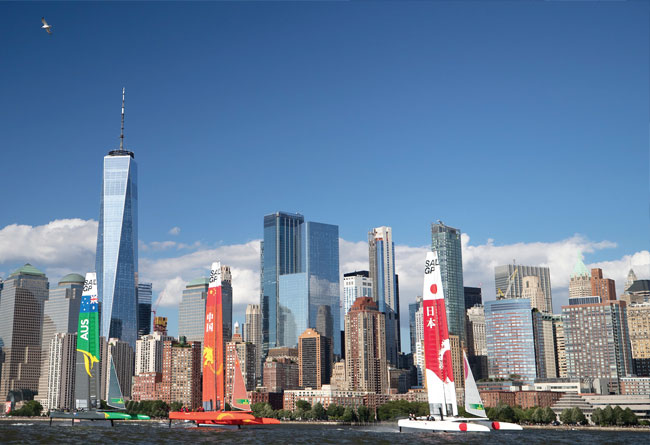

The F50 cats are so astonishingly fast that SailGP needed to adopt new B&G technology across its chase boat and race management fleet to ensure reliable and accurate data to run the racing… at 50 knots
The technology focus for the new SailGP global championship has been on the F50s and for good reason. The F50 is a new class of boat that shares DNA with the revolutionary cats used in the last America’s Cup. The boats are turbo-charged with advanced foils and sophisticated control systems. It has been an impressive undertaking and has delivered yet another step forward for high-performance sailing.
F50s are capable of more than 50kts (60 mph) and can make 30kts downwind in less than 10kts of breeze. The technical advances are clear to see. ‘Race Control set and modify the course on a PC-based navigation system, which is sent to the LiveLineFX servers for processing and redistribution’, explains Matt Eeles, R&D lead for B&G. In addition to a Fibre Optic Gyro compass, the committee boat utilises a B&G H5000 motion corrected wind solution to calculate true wind data, which is used by the Principal Race Officer to set the course axis and length. It also provides the true wind data for the layline and wind broadcast graphics.
The B&G Multifunction Displays (MFDs), show the live race data as:
- Moving vessels, like AIS targets
- A course layout with marks; target and actual positions
- Course and spectator boundaries
- A Twitter-like “chatter feed” giving updates of race information
- Course updates and changes which are committed before or during a race
This information is received on all B&G MFD-equipped vessels within the SailGP combined fleet, which are on the LiveLineFX telemetry network.
The B&G MFDs are off-the-shelf units with custom software developed under the SailGP and B&G technology partnership. This has enabled Race Control to use the B&G MFDs as a central means of communication and visualisation for the on-the-water race management team.
One of the key features of this system is the ability for Race Control to send out course data to the 22+ support vessels, including:
- Team chase
- Mark set
- Marshall
- On-the-water umpires
- TV camera catamaran
- Salvage
- Safety/medical
- Race Control
Graphically displaying desired mark locations and course boundaries on the B&G MFDs allows mark set boats to navigate to a precise position and set their course marks. Each mark has a GPS telemetry transponder that identifies its precise position and name so it can be tracked within the LiveLineFX telemetry system.
The custom software also allows Race Control to define the boundaries of the course as well as the spectator boat boundaries, which are displayed on the B&G MFDs enabling marshall boats to accurately and safely patrol the racecourse while allowing spectators to be close to the action.
‘Once Race Control has established the course axis and race configuration, the race can be “committed” and pushed out system wide,’ Eeles says.
‘Every race yacht and every mark has a differential GPS unit which means a resolution of up to 2cm is possible. This level of accuracy is required not only for digital umpiring, but helps to produce the augmented onscreen graphics that are delivered for TV broadcast by the patented LiveLineFX Technology. The marks also have their own solid state compasses and sonic wind sensors which report back to Race Control.’
When it comes to race umpiring, given boatspeeds that get well into 40 kts+ at times, remote umpiring is the only realistic option. As a result, all tracks, speeds, headings and orientations of the race yachts are transmitted live to an “umpire booth” located on land, where three umpires can review the data in a similar way to football’s VAR system. From there they can issue and monitor penalties.
But employing modern technology within SailGP is not solely about the cut and thrust of the racecourse. A B&G 3D StructureScan Sonar System is on board the salvage and safety/ medical vessels to map shallow areas, especially close to the launch places, to ensure there is no risk to the long foils of the race yachts.
‘When it comes to transmitting and receiving the data,’ says Eeles, ‘prior to each event, the LiveLineFX team installs a private LTE cellular network in the local event area which enables all the race yachts to provide live streaming telemetry data to Race Control and the umpire booth. This is also the means by which Race Control can commit changes to the racecourse boundaries for display on the MFDs.’
Click here for more information on B&G »
We invite you to read on and find out for yourself why Seahorse is the most highly-rated source in the world for anyone who is serious about their racing.
To read on simply SIGN up NOW
Take advantage of our very best subscription offer or order a single copy of this issue of Seahorse.
Online at:
www.seahorse.co.uk/shop and use the code TECH20
Or for iPad simply download the Seahorse App at the iTunes store


